Twickenham Church Monuments, South West London
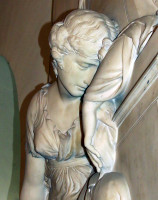

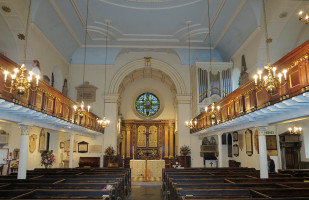
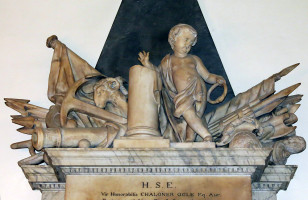
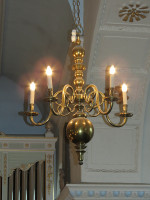
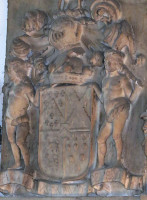
Twickenham Church, dedicated to St Mary, is fairly low, with a modest square tower of stone with buttresses and crenellations,
but its commanding position on a rise gives it prominence; this tower dates from the 15th Century Church on the site,
and the rest of the building, in brick, represents a new building of 1714-15, by the eminent architect John James,
a contemporary of Hawksmoor and with him, being one of the surveyors for the 50 New Churches initiative of 1716,
by which he built St George Hanover Square. The remarkable weathervane of cast iron on the old tower, with the vane itself
cut into what appears to be a toothy monster, is from the 18th Century rebuild.
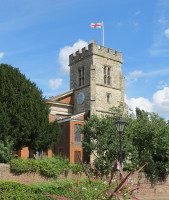 Twickenham Church, St Mary.
Twickenham Church, St Mary.
Inside, the Church is bright and high. At the altar end is a full-height arch, with a round window of moderate dimension
above the Reredos. The main windows, down the length of the Church, are arched, semicircular on the upper level, segmental below.
There are full length galleries to the sides of the nave, with monuments all the way upstairs and downstairs
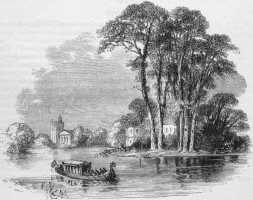 Approach to Twickenham Church by water, mid-19th Century view.
Approach to Twickenham Church by water, mid-19th Century view.
Monuments
The collection is extensive and broad, some 50-odd monumental panels, 9 each from the 17th and 18th Centuries,
over 30 from the 19th Century, and a few into the 20th. They cover some of the most favoured types of wall monument: Classical,
including on a grand scale, hanging drapes, obelisk monuments, and those from the 1800s and thereabouts designed as the ends
of caskets or chest tombs. The sculptural efforts include a pair of early portrait busts, very fine, one girl with a pot in
high relief, several cherubs and rather more winged cherub heads, and the usual draped and undraped pots,
in the round and in relief, and minor decorations.
All the monuments are in beautiful condition, extremely well looked after. Almost a third of them are either signed or known
to be by particular sculptors: the collection includes work b the eminent and prolific Sir Richard Westmacott RA,
the less eminent but equally prolific John Bacon Junior, the excellent J.M. Rysbrack and Peter Scheemakers among big names.
The monument to the most important personage buried in the Church, the poet Alexander Pope, is by Prince Hoare of Bath,
the simple one to his parents (and himself) is by Francis Bird, and there is also work by several minor statuaries and masons, including
a local man, John Mason of Twickenham.
17th Century Monuments
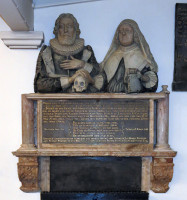
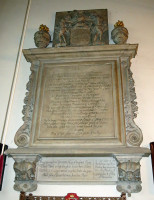 17 Century: Francis and Susan Poulton, and Lord Berkeley.
17 Century: Francis and Susan Poulton, and Lord Berkeley.
- Brigit (Harrington) Markham, d.1609, a large, dark marble panel with arched top, and a long inscription
in Latin, difficult to see properly.
- Francis Poulton, d.1642, of Lincoln’s Inn, Justice of the Peace etc, ‘employed in many and great Offices of
trust’, an important alabaster wall monument, with full portrait half-figures of him and his wife, Susan, on top.
These are extremely interesting and unusual, for we are more familiar with kneeler monuments of this period, which are likewise
painted, but usually have faces which are not true portraits. They face forward, and form a group, thus one of her hands
stretches across to rest upon his, which itself rests upon a jawless skull as a memento mori. His other hand is upon his breast,
and her other hand is upon a book, doubtless a Bible. His face is long, intelligent, rather sad, and is framed with a short,
trimmed beard and wavy shoulder-length hair, both painted white, for he is an elderly man. His clothing is rich,
with an unusually broad ruff, wide lapels, and a fur coat. His wife is shown a little plump, hooded and with religious garb,
and similar wide cuffs to her husband. Both are painted, and together form a rather touching group.
The inscribed panel below has pillars at the side, and carved mouldings below, all in pinkish alabaster, and a black central apron.
The monument is presumably but the surviving central part of some larger architectural construction,
with covering niche for the figures and some upper shelf or pediment with a coat of arms.
- William Reeves, d.1669, noting he was ‘sonne and heire of Rob[er]t Reeves of Faire Lee in Ye Isle of Wight
in Ye County of Southton, Gent[leman], who married Timothea Lowe, one of the Daughters and Coheires of Timothy Lowe of Bromley
in ye County of Kent’ – a black panel with surviving shelf under it; once there may have been much more.
- The Rt. Hon. The Lord John Berkeley, Baron of Straton, d.1678, noting his valour ‘In the Civill Warres
in the days of Charles Ye 1st’, his battles and honours. It goes on to note his happy marriage to Christina,
daughter of Sir Andrew Riccardo, ‘A young Lady of a Large Dowry & yet larger Graces & Virtues who also Enricht him with a
most hopefull Progeny’. The panel has frame with mouldings, and outer, receding side pieces which are of the scrolly type
at the base, and with carved flowers and leaves above. On top is a rectangular panel bearing the full coat of arms of
the Berkeleys, with male figures as supporters, and to the sides of this stand flaming pots.
At the base is a broad shelf, with two scrolled, carved supports below, bearing winged cherub heads etc,
between which is a small panel noting that the Berkeleys came from the Fitz Hardings, descended from the Kings of Denmark.
I would think that there was originally some other top, and the panel with coat of arms came from an associated monumental panel:
if designed for its current position it would have presumably had something like a cartouche surround.
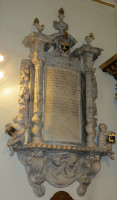
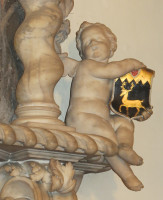
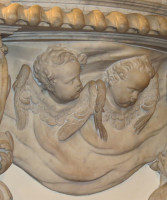
Baronet Sir William Humble, d.1680, and details.
- Sir William Humble of Stratford Langthon [Langthorne], Essex, Baronet, d.1680, and younger son,
also Sir William Hamble, of Twickenham, Baronet, d.1705. A grand mural monument in scale and conception and
Baroque ornament. The central panel is slightly domed, and to either sides are free-standing pillars, fluted,
Corinthian at the top and instead of having bases, resting on short helical pillars underneath, themselves resting on a
gadrooned (heavily corrugated like a shell) shelf. Further to the sides, heavy carvings of flowers and fruit all the way up,
and seated at the corners of the shelf, two plump naked cherubs, with little wings and fat limbs and jowly faces,
each holding a heraldic shield. They are plonked there, the copious flesh of the thighs apparently free from gravity.
At the top, a truly Baroque expression of a pediment, with really just the top of the triangle, arching inwards and outwards
to give perhaps a quarter of a pediment – shield of arms in a cartouche upon it – and to the sides,
vastly exaggerated short pillars, front and back, with flaming shell-shaped urns upon the top.
A bigger flaming pot is in the centre on the top of the pediment. Underneath the lower, gadrooned shelf, we have a bit more:
scrolled brackets to the side with a central field or apron are conventional, but here the scrolling is flamboyant,
unrolling at the top, splitting into curly Acanthus leaves at the base, and the central field is carved as if fabric,
out of which two more winged cherub heads emerge. What a splendid thing, perfect of its exuberant type.
- Sir Joseph Ashe, Baronet, d.1686, wife Mary [Wilson] Ashe, d.1705, and
Martha Ashe, d.1714, a daughter. Another prodigiously sized and decorated panel. The inscribed marble panel
has a rich border, with various relief carvings on the side pieces: particularly nicely captured are the bunches of grapes
hanging from mixed flowers on the right hand side, but the naturalistic carving in excellent throughout.
Tied to the outside of these sides are hanging drapes, knotted at the top. Above, an entablature supports a small shield of arms
on a concave-sided pedestal, and to the sides of this are two cherubs, each leaning on an urn.
This alternative arrangement to a pediment is unusual, and possibly represents some later rearrangement of an original pedimented
monument. The heavy base has a gadrooned shelf, under which are a pair of winged cherub heads almost touching.
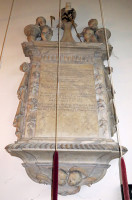
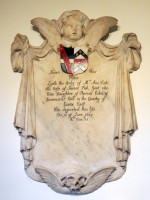
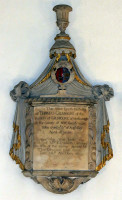
Late 17th Century ornateness: Monuments to Baronet Ashe, Anne Fish, and Thomas Gilmoore.
- Mrs Ann Fish, d.1687, daughter of Thomas Eden of Dorenards’ Hall, Essex. Carved as a hanging drapery,
supported at the top on a winged cherub head, tied in knots at the top corners, then falling freely to each side.
Under the cherub head is a painted shield of arms, and at the base, peeking out from under the cloth, is a death’s head,
the skull missing the lower jaw, as is more common than not. This is really rather early for such hanging drape monuments,
though St Leonard Shoreditch has one of similar date. Very finely carved.
- Thomas Gilmoore, d.1691, and wife Elizabeth Gilmoore, d.1699. A slightly domed panel
with side pieces decorated with heavy, frondy branches, a gadrooned upper shelf, and a plainer lower shelf, all enclosed by a
tent-like surround carved as hanging drapery. At the top is a triangle of drapery depending from a tasselled, bell-shaped top,
with a summit pot. In front of this are painted arms ona small cartouche. The drapery behind is pulled to the corners
of the upper shelf, where it is tied in large knots, and then hangs freely to the sides almost to the base, with a fringe.
Under the lower shelf, a narrow corbel is carved with a kissing pair of cherub heads. In several different marbles,
and with gilding.
- Mathew [Matthew] Harvie, d.1693, a flaming urn balanced on an upturned bell-shaped base raised on a
square pedestal, standing in a corner. Not the usual sort of Church monument, and presumably brought in from the churchyard,
and recorded as being in the Chancel prior to 1859. Below the inscription is a carved cartouche, directly on the marble,
bearing a shield of arms. On the visible side is an inscription to Harvie’s wife, unnamed but recorded as
Lady Francis Whitmore, d.1690, which although utterly outside the scope of these pages, must be quoted in full: ‘Faire kind, and true! A Treasure each alone: // A Wife, a Mistress and a Freind in one. // Rest in this Tomb, rais’d at thy Husband’s cost, // Here, sadly summing what he had, and lost.’
Come, Virgins, er’e in equall bands you joine, // Come first, and Offer at Her sacred shryne. // Pray but for halfe the Virtues of this Wife // Compund for all the rest w’th longer life // And with your Voioes [Vows] like her’s may be return’d // So lov’d when living and when dead so mourn’d // I: D.’ – the lines were written by Dryden.
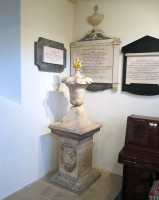 Corner with the Harvie monument.
Corner with the Harvie monument.
18th Century Monuments
- Alexander Pope, d.1717, and wife Edith, d.1733, erected by the poet to his parents
[filius fecit – the son made it] ‘and himself’, with a short Latin inscription; he had said that the inscription to himself
on that monument should be solely ‘filius fecit, et sibi’ [and friends]. Panel with wide border and a pediment, enclosing the initials
‘D.O.M’ (Deo optimo maximo, or ‘To God, most good and greatest’, originally referring to the Roman Jupiter, later Christian),
and with a chimney-like pedestal on top which would once have borne a small pot or coat of arms or other device.
The monument is known to be a minor work by the notable sculptor Francis Bird. The grand monument to Pope is noted below.
- Hamon L’Estrange, d.1728, and wife Sarah, d.1746, with a completely open
curved pediment above, and receding scrolled side pieces carved with Acanthus leaves, and a shelf below,
in variably coloured marbles, characteristic of the time.
- Nathaniel Pigott, d.1737, a barrister who was ‘Possessed of the highest Character // By his Learning,
Judgment, Experience, Integrity, // Deprived of the highest Stations // Only by his Conscience and Religion...’
The earliest obelisk monument in the Church, the black obelisk accounting for around half the total height of the monument,
and bearing upon it a carved cartouche with painted shield of arms. The base of the obelisk, and shelf underneath, are carved
from a streaky dark and pale marble, and to the sides are two flaming urns, free-standing, in white marble. Below the shelf
is the main panel, with double border, the outer curly side pieces and base being recessed and using different coloured marbles.
At the base, two corbels at the sides, and a central apron carved in low relief with a wreath and flourishes.
The separate pieces are all of fairly large size and blocky, giving a particular character to the monument,
and this is a work by the important sculptor Peter Scheemakers.
The inscription was written by Alexander Pope.
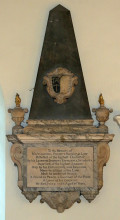
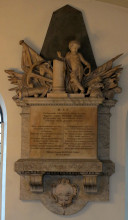 18th Century obelisk monuments: Nathaniel Pigott and Sir Chaloner Ogle.
18th Century obelisk monuments: Nathaniel Pigott and Sir Chaloner Ogle.
- Sir Chaloner Ogle, d.1750, Baronet and Admiral of the Fleet who defeated a notorious pirate called Roberts
and took his three ships, with a long Latin inscription, erected by his wife Isabella.
The panel forms the centrepiece of a rather magnificent construction, being the forward-set plinth for an upper shelf
bearing a broken pillar with a small boy or cherub standing next to it, and behind which is an architectural trophy,
which is to say a carved collection of weapons laid across each other and fanned out: here we have spears, a great cannon, axe,
club, more spears with flags draped upon them, a full flagstaff, anchor, ram’s head for a battering ram and a dimly seen peacock’s
head perhaps from an ecclesiastical sceptre, and a Greek Corinthian helmet - see picture at top of page (you will need to click to enlarge). The broken pillar is indicative that the deceased
was the last of his male line. The cherub, rather gruesome, stands with one hand raised theatrically, the other holding a circlet
which on close inspection is a snake biting its tail, here a symbol of eternity and rebirth, and has his legs crossed.
He wears only a cloak, implausibly rising up at the front to spare his modesty. Behind the ensemble is a black panel cut
as an obelisk. At the bottom of the monument, below the inscribed panel is a heavy shelf with light scrolling on the front,
two solid scrolled supporting brackets – they do look solid enough to bear the weight of marble above, and an apron below bearing
a cartouche with now nearly disappeared arms. This monument, of grandeur and solidity, is signed by
John Michael Rysbrack, contemporary of Scheemakers noted above and also from an Antwerp descent, and dated 1751.
- Pauncefote Green, d.1757, and wife Susanna, d.1771. An oval panel of speckled marble,
with attached upon it a half-sculpture of a wide-bodied pot or urn, narrow of neck and foot,
with the brief inscription written upon it. Below, a plinth, a shelf, and a cartouche of arms, painted.
A refined, restrained composition.
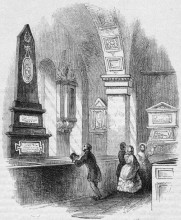
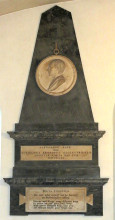
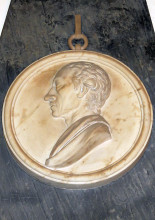
Alexander Pope monument, by the sculptor Prince Hoare of Bath.
- Alexander Pope, d.1761, the most famous character buried in the Church, noting that the monument was
‘For one who would not be buried in Westminster Abbey’, and with the lines by the poet that ‘Heroes and Kings’ your distance keep.
// In peace let one poor Poet sleep; // Who never flatter’d folks like you: // Let Horace blush and Virgil too.’
Needless to say, Pope designed the monument for himself. It is an obelisk monument, the obelisk being well over half
the total height, and having upon it a roundel bearing a profile portrait of Pope, hanging form a ringlet - the engraving shows that
this used to have a knot, and a carved wreath above.
Beneath the obelisk is a shelf and then two panels, separated by a further shelf. The two small inscribed panels
have wide borders of similar darkness to the obelisk, and the shelves, though a different marble, are also dark,
so there is a unity to the whole rather than an appearance of a monument in two unequal halves: a nice compositional feature
surprisingly unusual. The piece was commissioned by Pope’s friend, William Warburton, and is the work of the sculptor
Prince Hoare of Bath.
- Jane Blicke, d.1793, with the short effective inscription ‘Beloved Wife, exemplary Mother,
excellent Woman. // Adieu: // Thy Virtues will receive Reward in HEAVEN.’, and husband Sir Charles Blicke, d.1815.
A broad oval panel, with upon it standing a high relief pot with a drape falling symmetrically from it,
and completely round the sides of the panel; at the base, a carving of a rolled up kerchief with a shield of arms upon it, painted - see picture below left.
The mason was John Bingley of London, one time partner of the sculptor J.C.F. Rossi.
A later member of the family, Charles Blicke, has a panel noted below.
- Ann Littledale, d.1794 (?), the question mark because the date is in Roman numerals, MDCCLXCIV, and the L and the last C seem incompatible – it could be the L is wrong, giving 1794 , or the C, giving 1764. 1794 looks more likely from the style, I would think. The surround to the panel is a stripy black and white marble, and aroud this is a Baroque frame with various parts of a segmented circle; the largest being a rounded pediment at the top with an Aladdin-style lamp carved in high relief within it, asymmetrically draped. At the base, two crossed branches in low relief.
- Thomas Wildman MP, d.1795, erected by his wife, Sarah Wildman, d.1830,
who has a panel attached at the base. It looks as if it came from the 20th Century: the inscription is within a semicircle,
or almost semicircle, surrounded by a narrow rim, and this forms the front of a casket, with slightly waved undulations upon it,
and a shallow pediment above without entablature; a painted shield of arms is within this, and directly below,
a blank shield upon the rim of the semicircle - see picture below right. At the base, a sort of shelf with central low relief carving of a wreath
with two fronds across it, and to the sides, two scrolly brackets; his wife’s panel is plain except for two roundels.
What to make of this? I would suppose it the reconstructed remnant of a decayed monument,
with the casket and waves added in modern times, novel but not inappropriate. One of the original bits is signed by Moore & Smith
of London; John Francis Moore was the better known of the partnership, and he also made monuments on his own account.
The monument to Lady Margaret Wildman is noted below.
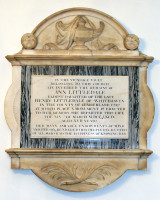
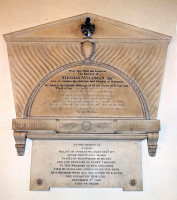
19th Century Monuments
- George Gostling, d.1782, and wife Anne, d.1799, (the monument being dated 1800)
with a brief inscription noting their son erected the monument, which is important. It is a proper example of an obelisk monument,
in fact being nearly all obelisk, perhaps four fifths of the total height, with the inscription confined to a modest panel
with curved bottom edge forming an apron to the monument. To the sides of this panel are two broad pilasters,
carved in low relief with flowering poppies, symbol of dreaming and endless sleep as the obelisk is a symbol of death and rebirth,
and behind is a thin, grey, veined marble backing. The obelisk itself bears a splendid relief statue of a mourning girl,
half kneeling against a chest tomb; behind her head and above is a pedestal bearing a pot, draped,
the cloth hanging down far over the side. The girl herself is a chaste 18th Century creature, with ringletted hair, slender neck,
slender arms and perfect wrists to her small hands, barefoot and dressed in Hellene drapery:
a diaphanous garment tied under the breasts, and a heavier sweep of drapery which runs from behind her shoulder in a swirl down
behind her exposed arm and back, then held by her hand and upwards over the thighs and back again – this provides a satisfying oval
shape binding the composed figure together harmoniously. Her other arm, on which she bows her head, has a longer sleeve of drapery
than the frontal one, some outer garment merging with the drapery behind her. Behind her back foot is a small swan feeding her young,
symbol of sacrificing motherhood, except it would normally be a Pelican – perhaps considered too Catholic for those times.
The young, with their short necks, look like a different species altogether. This is a monument made by a master sculptor,
and surely one of the most exquisite pieces by John Bacon Junior, who signs it at the side,
and dates it 1800.
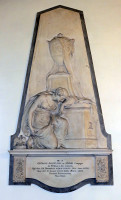
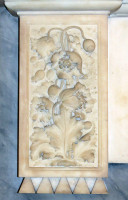 George Gostling, d.1782, and wife Anne, by John Bacon Jr.
George Gostling, d.1782, and wife Anne, by John Bacon Jr.
- Richard Owen Cambridge, d.1802, wife Mary, d.1806, two daughters Charlotte, d.1823,
and Catherine, d.1784, grandson Richard Owen Cambridge, d.1775, and
Revd. George Owen Cambridge, Archdeacon of Middlesex and Prebendary of Ely, d.1841.
Plain panel with upper and lower shelf and nothing to distinguish the date, so it could have been put up anywhere between 1802
and after the death of the Archdeacon in 1841.
- Lucia, Viscountess Clifden, d.1802, wife of James, Lord Viscount Clifden of Ireland, her sister
Agnes Breton, d.1802, wife of Harvey Breton of Forty Hill (perhaps it should be Forty Hall) in Middlesex,
as one of a pair of joined panels, the other being to the daughter of a related Viscount (Henry Viscount Clifden and Lord Mendip),
the Hon. Caroline Anne Agar Ellis, d.1814. Plain, with coat of arms at the top of each one,
and an inscribed line border, and little corner blobs: they could have so easily had something sculptural.
- Sir Richard Perryn, Knight, d.1803, and wife Dame Mary (Browne), d.1795.
Broad panel with fluted, square pilasters to the sides, a baroque pediment above bearing a shield of arms, and at the summit,
embedded int eh wall rather than on any backing panel, a flaming pot. An apron and two brackets at the base.
- Major John Perryn, d.1805, ‘who lost his life by a fall form his Carriage at Ulverstone in Lancashire’,
erected by Mary and Alexander Hatfield, his sister and brother in law, also commemorated by a panel (see below, 1834).
As a simple tomb chest end, in pale, streaky marble, with little feet below, and an upper rim indicating side pilasters
and a central pediment.
- James Alexander Hodson, d.1810, an infant, plain panel with two triangular pieces at the side,
each bearing a circlet.
- Edward Osborn Pocock, d.1813, ‘who unfortunately perished at sea’. A round panel with narrow rim
on a dark rectangular backing panel with upper shelf, and below, two feet elegantly carved as flowers –
the work of the sculptor Henry Rouw, Portland Road, London, brother of the more prolific Peter Rouw. We can only wish he had been commissioned to do more
than the slight sculptural work on this panel.
- Henry Cole, d.1815, a rather long inscription completely filling up to the edges a panel,
made in two parts, of a rectangle of marble with a half circle at the base. With a narrow shelf at the top,
and a small shield containing a picture of a cow underneath.
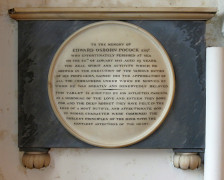
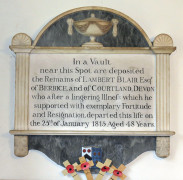
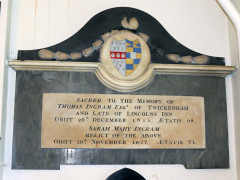
Early 19th Century wall panels: Pocock, Blair, Ingram.
- Lambert Blair, d.1815, panel with upper and lower shelf, side pilasters topped by rounded acroteria
and carved brackets below, the whole rather in the manner of a headboard from a bed, rounded pediment of grey marble
above containing a relief carving of a broad pot in an Adam style; curvy apron of the same marble below bearing a painted shield
of arms; there remains the outline of a pair of festoons tied on pins which were once attached to it.
- Thomas Ingram, d.1815, and wife Sarah Mary Ingram, d.1827.
In differently coloured marbles, unusual for this time. The pale central panel is on a broad grey marble backing
cut with small feet, and at the top has a shelf, pale again, depressed at the centre to accommodate a circlet with painted shield
of arms upon it. Over this is a festoon of simply carved flowers, a little damaged, and behind, a wavy black backing panel.
- Thomas Terry, d.1816, panel with clipped corners, on a round-headed black backing, with an upper shelf
on which rests a simple pot with flame. At the base, two moulded brackets. A simple but elegant piece, a little out of the ordinary
in design, signed by W.& C. Thompson of London. The firm, father and son (Charles was the father),
produced monumental tablets during nearly the entire first half of the 19th Century, their work being mainly seen in London
and the surrounding counties.
- Henry Church, d.1819, and wife Sarah (Lonsdale), d.1844. A crisp tomb chest end,
with little feet below, entablature and lid above, and above that, a small carving of a bush with the word ‘Virtute’
(similar to ‘act with virtue, do what is right’) on a ribbon. Beneath, a coat of arms, and a second ribbon, bearing the words
‘Veritas Trumphat’ (Truth alone triumphs). The whole is on a black, rectangular backing panel with two segments of a circle above
and below, and is signed on one of the two blocky supports by the mason, Gardner of Cheltenham, who has works surviving elsewhere.
- Joseph Charles Mellish, d.1823, and wife Caroline, d.1824.
White marble panel with wavy lower edge and upper shelf, against a shaped black backing with little feet and above,
a pediment shape on which is a painted shield of arms. By the local statuary John Mason of Twickenham.
- Richard Twining, d.1824, and wife Mary (Aldred) Twining, d.1803, of the Strand –
there remains a tea shop there to this day, with pictures of two Chinese tea-drinkers. Tall panel with upper and lower shelf, and above, a shield of arms
with crossed frondy branches, the black backing panel being cut to leave a pediment shape to accommodate this.
- The Rt Hon. Lady Margaret Wildman, d.1825, a daughter of the 6th Earl of Wemyss and March.
The inscription occupies the lowest part of a tall plinth, covered by a carved, hanging drape depending from a rounded pot on top;
beneath is a shelf and base with carved devices of a thistle and Tudor rose, and on the black backing panel is the signature
of no less than Sir Richard Westmacott RA, of 14 South Audley Street, London – where there is a blue plaque to him.
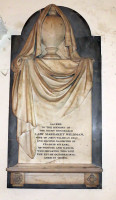
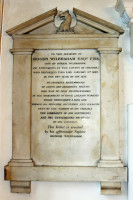
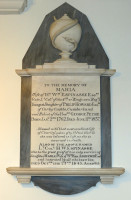
Tall 19th Century signed panels: Lady Wildman, Wilbraham, Espinasse.
- Robert Burnett, d.1826, of Rock House Brighton. With fluted side pilasters, an upper shelf
and a bornderless pediment, and all on a shaped black backing. At the base, a segment of a circle forms an apron to this otherwise
austerely Classical monument, on which is a carved low relief coat of arms, painted, with motto. The carving of the arms
is most delicate, and it is interesting to see that the plaque is signed by John Mason of Twickenham.
- John Twining, d.1827, and wife Mary Ann (Haynes), d.1838.
A plain panel cut with little feet, and a small shelf above.
- Maria Marow Eardley-Wilmot, d.1827, with a Biblical quotation, as a casket-end standing on a shelf,
with carved lion’s feet. The whole on a black backing panel.
- John Addison Carr, d.1828, Curate of the Parish, erected, curiously, ‘by the inhabitants at large’,
with a eulogy. An austere borad tablet with roof-like upper shelf and broadening at the base via a series
of three steps to a heavy base of streaky marble: each step edge is carved with repeating patterns,
the lowermost being like scales.
- Roger Wilbraham, d.1829, erected by his nephew, George Wilbraham. Austere Classical panel,
with flat side pilasters, entablature and pediment, the latter broken to admit a carved head of some beast, perhaps a wolf.
The base is a solid shelf with two solid brackets. By the mason C. King of Chenies St, Tottenham Court Road, London. See picture above, centre.
- Alexander Hatfield, d.1832, and wife Mary (Perryn) Hatfield, d.1834,
tomb chest end cut with small feet and with a shelf on top, on a black backing carved with a curve at the base.
Another monument by John Mason of Twickenham.
- Charles Tufton Blicke, d.1837, erected by his sister Frances Otway.
With fluted sides to the frame, upper and lower shelf, both gently corrugated, and a curved sort of pediment above, rimless,
incorporating a low relief coat of arms with ribbon below. At the base, two little feet with a carved leaf on each;
the black backing reflects the broad outlines of the main panel and is made in several pieces. (see Jane Blicke tablet above)
- Maria Espinasse (nee Howard), d.1837, and husband Lt. Col. H. W. Espinasse, d.1845.
A strange one. The white panel has broad upper and lower shelf with recessed sides, so the dark backing panel on each side
appears as a pilaster; at the base, a small apron. Above is a short obelisk – but this is no conventional example
because the obelisk is less than two-fifths of the total height of the monument, with upon it a carved pot,
more attached than high relief, with a snake coiled around it, tongue extended. Why a snake?
It is the symbol not of betrayal but of wisdom, though this is really late for such symbolism except in association
with an allegorical figure (see this page for more on snake allegory), and the beast has a malevolent look. Regardless of the appropriateness of the image,
it is a highly accomplished work and most striking, the last work in the Church by John Mason of Twickenham, who also made the
tablets to Joseph Mellish, Alexander Hatfield and Robert Burnett noted above. See picture above right.
- William Jones Burdett, d.1840, erected by his brother Sir Francis Burdett, Baronet.
A rectangular panel with the wording of the rather long eulogy right up to the edges on the side, despite the availability
of space at top and bottom. Aside from this idiosyncrasy, the monument is conventional: upper and lower shelf,
protruding enough on each side that thin side frames to the central panel could have been accommodated, a draped pot on top
carved in high reliefs, with the drapes gathered rather nicely into knottish lumps at the sides, and at the base,
crossed palm fronds with a heraldic lion head, all crisply carved. There is a shaped black backing plate.
- Henry Hawkins, d.1841, and sister Laetitia Matilda Hawkins, d.1835,
as a tomb chest end in white marble, with upper shelf and lid, and small feet, on a shaped black backing with its own supporting
feet.
- Frances (Sharrer) Proby, d.1843, wife of the Vicar, Revd Charles Proby. Plain panel on a grey,
streaky backing plate of marble with cut out corners. A monument plain enough that it looks modern.
- Frances Tufnell, d.1846, daughter of General Lord Strafford. Panel with upper shelf
which forms the stepped base of a relief carving of a narrow-footed pot, draped asymmetrically, decorated with repeating patterns
and with the name France[s] on the body. On a black backing shaped in obelisk fashion above, though we would normally
have a clearer divide between upper and lower parts on an obelisk monument.
- Angelina Dorinda Barry, d.1850, a child. Tomb chest end with large pediment-like top,
on the front of which is a carving of a flower broken from a stem with two not-yet open flowers upon it,
symbolic of the daughter plucked in the flower of her youth from her parents.
- Louisa Emily Caroline Griffiths, d.1896, plain panel on a rectangular black backing
with clipped corners.
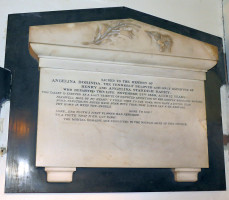 Angelina Barry monument, with broken flower.
Angelina Barry monument, with broken flower.
20th Century Monuments
- Henrietta Montgomrey, d.1905, plain panel of brownish tinged marble – apart from the colour,
we might have expected some ornament given the date.
- Major Gordon Stollard, d.1916, killed in France, shaped panel with inscribed line border,
small regimental motif carved at the top under a protrusion, and a wide outer border of black marble.
- James Bigwood, d.1919, MP for East Finsbury and later Brentford, and wife Marian, d.1909.
A bronze panel in a by-then antiquated style, with Corinthian side pillars, rounded upper pediment, bearing a wreath
with the dates of the couple’s deaths, and blank lower panel and small apron between short pedestals and curly brackets:
it would have looked in place 150 years previously in white marble.
- Francis Walter Etherington, d.1933, churchwarden, a plain, speckled panel.
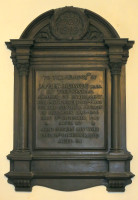 James Bigwood MP, d.1919.
James Bigwood MP, d.1919.
Also in the Church
- An ancient brass to Richard Burton, d.1443, Chief cook to the King, and wife Agnes.
- Several modern brasses, notably to John Edward Meek, d.1884, inscribed with a crucifix beneath a portico with Ionic pillars, spandrels etc, and to individuals killed in action in World War I.
- A solid, wooden chest, filled with Bibles, apparently 17th Century, with an impressive mechanism to lock it.
- The Reredos, high and the full width of the Chancel, in wood, with two pairs of Corinthian pilasters to the sides, two arches in the centre, and much gilding. Early 18th Century according to those who study such things.
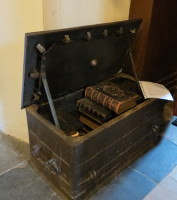
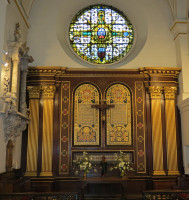
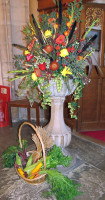
Chest, Reredos and Font.
- The Font, c.1714-15 according to the Royal Commission of Historic Monuments, pale stone, and gadrooned at top and bottom with octagonal curvaceous shaft between. A simpler version has been made in wood and stands in a corner.
- A strange oil painting showing a seated girl holding two infants, rather over-sweet.
- A collection of bells of the sort used to summon hired help, in Memoriam George Bradford, d.1963.
- Several floor slabs, 18th Century, of which we may note that to the Countess of Drogheda, d.1735, with arms including an elegant dog and a heraldic sea-horse with curling tail.
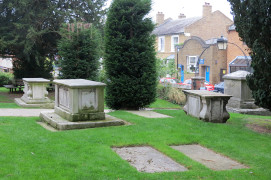 Tomb chests in the churchyard.
Tomb chests in the churchyard.
Outside, the Church stands in its own grassy churchyard. The monuments are mostly plain, but we can note one to
Mary Beach, d.1725, the nurse of Alexander Pope, who erected the monument, and another to
Thomas Twining, d.1741, and added later, his wife Margaretta, d.1751, erected by their children
to the memory of ‘a most Indulgent and Worthy Parent’. The piece has a Classical surround, open pediment, with supports
to the sides bearing small carved hanging flowers. At the base is a central shield of arms in a cartouche.
There are several tomb chests, neatly looked after, and among the various slabs now placed up against the walls
of the enclosure, a few with minor carving in relief, e.g.a skull and crossbones as a memento mori,
and one with a pair of winged cherub heads. Round towards the river side are the hexagonal base of perhaps a bird table or sundial,
to Nora Aris, d.1960, without adornment, and a Churchyard Cross with Crucifixion, as a War Memorial.
With many thanks to the Church authorities for permission to show pictures of the monuments inside; their website is
http://www.stmarytwick.org.uk/about-stmarys/history.
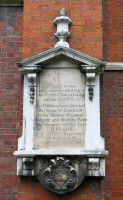 Thomas Twining, d.1741, exterior monument.
Thomas Twining, d.1741, exterior monument.
Top of page
Also in Twickenham: York House Gardens statues // Radnor Gardens War Memorial
Nearby: Teddington Church monuments // Mortlake Church monuments // Kew Church monuments // Richmond Church monuments // Hampton Church monuments
Monuments in some London Churches // Churches in the City of London // Introduction to church monuments
Angel statues // Cherub sculpture
London sculpture // Sculptors
Home
Visits to this page from 18 Jan 2015: 10,461






 Approach to Twickenham Church by water, mid-19th Century view.
Approach to Twickenham Church by water, mid-19th Century view.

 17 Century: Francis and Susan Poulton, and Lord Berkeley.
17 Century: Francis and Susan Poulton, and Lord Berkeley.



 Corner with the Harvie monument.
Corner with the Harvie monument.

 18th Century obelisk monuments: Nathaniel Pigott and Sir Chaloner Ogle.
18th Century obelisk monuments: Nathaniel Pigott and Sir Chaloner Ogle.






 Angelina Barry monument, with broken flower.
Angelina Barry monument, with broken flower.
 Tomb chests in the churchyard.
Tomb chests in the churchyard.
 Thomas Twining, d.1741, exterior monument.
Thomas Twining, d.1741, exterior monument.